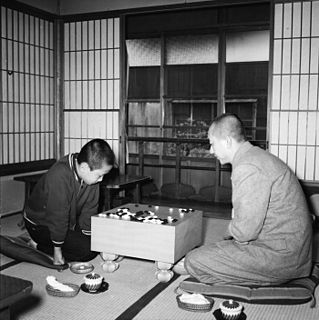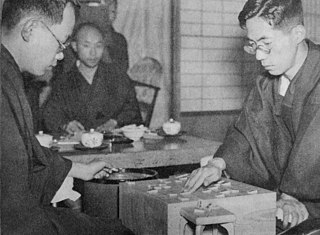Related Research Articles

The Master of Go is a novel by the Nobel Prize winning Japanese author Yasunari Kawabata. First published in serial form in 1951, Kawabata considered it his finest work. Sharply distinct from the rest of his literary output, The Master of Go is the only one of Kawabata's novels that the author considered to be finished.
Meijin (名人) means "Brilliant Man". It is the name of the second most prestigious Japanese Go Tournament. It also refers to a traditional Japanese title given to the strongest player of the day during the Edo period.
Masao Kato Honorary Oza, also known as Kato Kensei, was a Japanese professional go player. A late bloomer, Kato won 46 titles, including the Oza eight times in a row. He also became the second player to reach 1,200 career wins, behind Rin Kaiho.

Cho Chikun25th HoninboHonorary Meijin is a professional South Korean Go player and a nephew of Cho Namchul. His total title tally of 75 titles is the most in the history of the Japanese Nihon Ki-in. Cho is the first player to hold the top three titles—Kisei, Meijin, and Honinbo—simultaneously which he did for three years in a row. Cho is the first in history to win all of the "Top 7" titles in Japan which he achieved by winning the Oza in 1994. Cho U in 2011 and Iyama Yuta in 2013 would duplicate this feat, both by winning the Kisei. He is also one of the 'Six Supers' Japanese players that were most celebrated in the late twentieth century, along with Rin Kaiho, Otake Hideo, Takemiya Masaki, Kato Masao and his classmate and arch-rival Kobayashi Koichi. He is the author of several books on Go.

Rin Kaihō or Lin Haifeng is a professional Taiwanese Go player who made his name in Japan. He is, along with Cho Chikun, Kobayashi Koichi, Otake Hideo, Takemiya Masaki and Kato Masao, considered one of the 'Six Supers' that dominated Japanese Go world in the last three decades of the twentieth century.

Yuta Iyama Kisei, Honinbo, Meijin is a Japanese professional Go player. In April 2016, he became the first player in Japanese history to hold all seven major titles simultaneously. In January 2018, Iyama became the first professional Go player to be awarded Japan's People's Honour Award.
Koichi Kobayashi is a Japanese Go player. He is one of the 'Six Supers' who championed Japanese Go in the last three decades of Japanese Go.
Professional Go players in Japan are given the title of "Honorary" title holder if they either win the title ten times in a row, or have won the title five times in a row or ten times in total and reach the age of 60 years or retire. Below is a list of the honorary title holders and which title they are honored for.
Hideo Otake is a Japanese retired professional Go player.
The 1st Kisei was the birth of a new Go tournament. Since this was the first year of the tournament, there was no set challenger or holder. From the 2nd edition on, there has been a playoff between challengers. At the time, it was the highest paying tournament there had ever been, and would be until the creation of the Ing Cup. Fujisawa Hideyuki's win would mark the beginning of a six-year defense of the Kisei title from 1977 to 1982.
Shuzo Ohira was a professional Go player.
Toshiro Kageyama was a professional Go player.

Meijin (名人) is one of the eight titles in Japanese professional shogi, and is the most prestigious title, along with Ryūō. The word meijin refers to a highly skilled master of a certain field.
The 1st Igo Masters Cup began on 24 February and ended on 23 July 2011. Eleven players participated: Kobayashi Koichi, Kudo Norio, Rin Kaiho, Kataoka Satoshi, Hane Yasumasa, Ishida Yoshio, Takemiya Masaki, Cho Chikun, O Rissei, Kobayashi Satoru, Otake Hideo.

Yasuharu Ōyama was a professional shogi player, 15th Lifetime Meijin and president of Japan Shogi Association. He studied shogi under Kinjiro Kimi. He won 80 titles, 44 other type tournaments and 1433 games in life, and was awarded five lifetime titles: Lifetime Meijin, Lifetime Jūdan, Lifetime Ōi, Lifetime Kisei and Lifetime Ōshō. Among his 80 titles, 18 were the Meijin title. He has appeared in the Meijin title match 25 times winning 18; he also holds the record for the most consecutive Meijin titles, the most overall Meijin titles, and being the oldest player to challenge for the Meijin title, at age 63 in 1986.

Yoshio Kimura was a Japanese professional shogi player who achieved the rank of 8-dan.
Kazuo Sugimoto is a Japanese professional shogi player ranked 5-dan.
Meijin (名人) is a Renju title in Japan. The Meijin title tournament, formally called the All Japan Renju Meijin-sen (全日本連珠名人戦), is played every year in Japan since 1962. The Meijin-sen tournament is one of the most important Renju tournaments in Japan.
Ichitarō Doi was a Japanese professional shogi player who achieved the rank of 8-dan, and was the first president of the Japan Shogi Association.

Tatsunosuke Kanda is a deceased Japanese professional shogi player who achieved the rank of 8-dan and also 9-dan, which was an honorary rank, after death.
References
- ↑ "meijin title, 1st edition, 1976". gobase.org. Retrieved 29 June 2011.